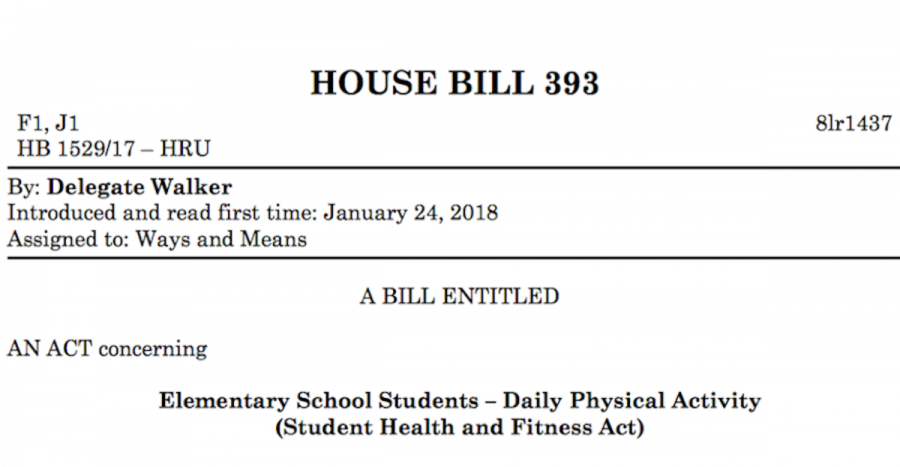Bill proposed to add P.E. time in Elementary schools
House Bill 393 requires more physical activity in elementary schools. The Student Health and Fitness Act was introduced into Maryland’s General assembly Jan. 24. Photo by Lily Jacobson.
March 4, 2018
The Student Health and Fitness Act, House Bill 393, was introduced into Maryland’s General assembly Jan. 24. If passed, the legislation would require more physical education in all Maryland public elementary schools.
Delegate Jay Walker, a Democrat from Prince George’s county, wrote the statewide bill and has been sponsoring it since 2010. Walker proposed that all elementary schools must devote at least 150 minutes to P.E. each week, the recommended time by SHAPE America. A minimum of 90 minutes must be physical education and the remaining time can consist of any moderate to vigorous activity including recess.
“We used to have 45 minutes a day of P.E. in elementary school. Now they might get one day out of five a week? That’s just … really not acceptable and not healthy,” Walker told Bethesda Magazine. “We know that childhood obesity has become a growing problem in America, but what have we done to combat childhood obesity in Maryland?”
Two middle school P.E. teachers at Newport Mill Middle School—Matthew Slatkin and Shannon Spencer—gave testimony on behalf of the bill to the house of delegates Feb. 9. They both agree that more P.E. will benefit students’ physical health and abilities in the classroom.
“It’s more than just physical health—its cognitive and mental health as well,” Spencer said. “There are tens of thousands of studies that have proven that exercise really will help improve more than just these kids’ physical fitness levels but also their classroom performance.”
Montgomery County currently requires 30 minutes of physical education per week, the lowest amount in all of Maryland, according to the Maryland State Department of Education. Neighboring districts like Frederick and Howard county both offer a minimum of 90 minutes.
“I lived in Montgomery County my entire life and I love Montgomery County. My daughters had P.E. once a week for 30 minutes when I lived there and I just figured that was how it was,” Slatkin said. “Two years ago, we moved to Howard County and now they get P.E. three days a week for 90 minutes. As a physical educator, I said that’s not right. The zip code you live in should not determine the number of minutes of P.E. you get.”
Many students said they loved their time in elementary school P.E. but noted the class periods were short and only once a week.
“I really enjoyed P.E. class and I remember wishing we had more time in it,” senior Freya Keto said. “Elementary kids need more P.E. The release of energy will help them concentrate more in their academic classes.”
Despite Slatkin and Spencer’s efforts and support from many county members, MCPS gave written testimony at the house of delegates in opposition to the bill.
“Scheduling increased time for physical education into the instructional day is difficult during a period of fiscal constraints, and the decision should be left up to local jurisdictions,” MCPS legislative aide Patricia Swanson wrote. “Currently, the issue of increasing students’ physical activity during the school day is being addressed in Montgomery County Public Schools through newly developed elementary physical education curriculum and the opportunity for physical activity during recess.”
Despite MCPS officials’ opposition to the bill, Wood Acres Elementary school P.E. teacher Natalie Stempel believes that its long term effects all positive.
“This bill will better prepare children for the reality of the effort and dedication it takes to formulate a ‘good habit’ and/or truly learn something,” Stempel said. “With a steady increase of the obesity epidemic, I believe it is more important, now than ever, to prepare and arm students with the proper knowledge and practices to tackle these issues.”
To view the full bill, visit the link here.







